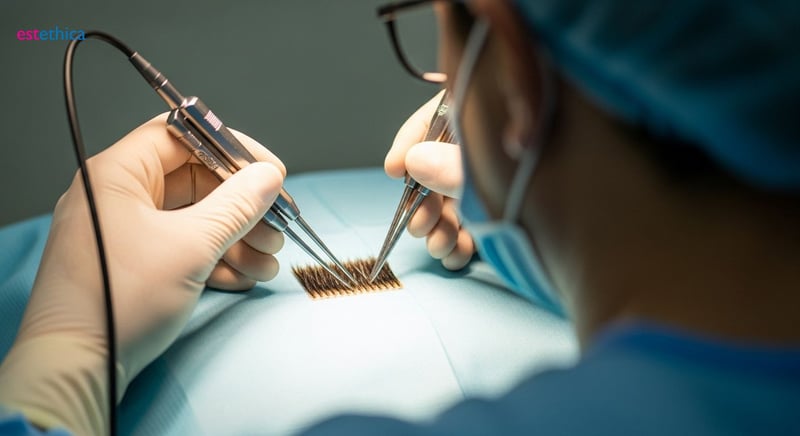Hair Transplant: Is it Right for Your Hair Restoration Journey?
Discover if a hair transplant is the right choice for your hair restoration journey. Learn about techniques, recovery, and results.
Hair loss can be a daunting experience, impacting not just your appearance, but also your confidence and self-esteem. Finding the right solution for hair restoration is crucial, and one option that stands out is hair transplant surgery. But, how do you know if it's the right step for you? In this comprehensive guide, we'll explore different facets of hair transplantation to help you make an informed decision.
Decoding Male Pattern Baldness: Understanding Your Hair Loss
Understanding the Causes and Solutions for Hair Loss
Male pattern baldness, also known as androgenetic alopecia, is primarily influenced by genetics and hormones, particularly dihydrotestosterone (DHT). DHT can shrink hair follicles, leading to thinner and shorter hair, eventually causing hair loss. Other factors such as age, stress, and certain medical conditions can also contribute to the progression of male pattern baldness. Recognizing these factors will allow you to seek appropriate hair transplant solutions.
Advanced techniques like FUE hair transplant and DHI hair transplant have revolutionized the field of hair restoration, offering minimally invasive options with natural-looking results. FUE involves extracting individual hair follicles from the donor area and transplanting them to the balding areas. DHI is a more refined version of FUE, where hair follicles are implanted directly without the need for creating incisions, ensuring higher graft survival rates and a more natural hairline. This makes hair restoration a viable option for those experiencing male pattern baldness. Consider discussing hair implants with a specialist to explore available options for hair restoration.
Exploring Hair Transplant Options
- Follicular Unit Extraction (FUE): A method where individual hair follicles are extracted and transplanted, minimizing scarring.
- Direct Hair Implantation (DHI): An advanced FUE technique that ensures higher graft survival rates.
- Beard Hair Transplant: Using beard hair as a donor source for those with limited scalp donor hair.
When considering hair loss treatment, it's helpful to explore real-life scenarios to see the range of possibilities. For instance, some individuals opt for FUE Sapphire to refine their hairline. Others choose advanced techniques offered by clinics, such as estethica Global. Success stories following FUE hair transplant highlight the potential for regaining a fuller head of hair.
Factors Affecting Hair Transplant Journey
- Initial Consultation: Determines suitability for the procedure, hairline design, and setting realistic expectations.
- Extraction Process: FUE or DHI techniques are employed to harvest healthy hair follicles from the donor area.
- Implantation Phase: Ensuring precise placement of grafts to match natural hair growth patterns.
Hair transplant is not just a procedure; it’s an investment in self-esteem. Clinics like estethica Global offer different hair restoration options, including specialized FUE services. The choice of technique often depends on individual needs, such as the density required or the donor area's condition, underscoring the importance of a personalized approach.

FUE Hair Transplant: The Modern Solution for Thinning Hair
Discovering the Nuances of FUE Technique
FUE (Follicular Unit Extraction) is one of the most advanced hair transplant techniques. Unlike traditional methods, FUE is minimally invasive and offers a quicker recovery time. It involves extracting individual hair follicles from the donor area and implanting them in the thinning areas. This technique ensures a more natural look and less visible scarring, making it a popular choice for those seeking discrete hair implants. FUE hair transplant is favored for its precision and ability to target specific areas needing more density or coverage. This method stands out due to its reduced recovery period and the absence of a linear scar, common with older transplant methods. Patients often report higher satisfaction due to the natural-looking results and minimal downtime, integrating back into their routines faster.
Benefits of Choosing FUE for Hair Restoration
- Minimally Invasive: FUE hair transplant involves tiny incisions, reducing discomfort and recovery time compared to strip excision methods.
- Natural Results: By transplanting individual follicular units, FUE achieves a natural hair density and growth pattern.
- Minimal Scarring: FUE leaves virtually undetectable scars, making it ideal for those who prefer shorter hairstyles.
When considering options like beard hair transplant, the extraction methods play a critical role in how natural the outcome appears. For example, clinics may use advanced tools to ensure grafts are harvested with minimal trauma, maximizing their survival rate once implanted. Some patients also explore FUE Sapphire, known for its precision in creating channels for graft placement, aiding in achieving higher hair density. These meticulous techniques demonstrate FUE’s commitment to providing aesthetically pleasing hair restoration solutions.
The FUE Process: Step-by-Step
- Extraction: Individual hair follicles are extracted from the donor area using a specialized micro-punch tool.
- Preparation: The extracted follicles are carefully prepared under a microscope to ensure their viability.
- Implantation: The prepared follicles are then implanted into the recipient area, following the natural hair growth pattern.
Clinics like estethica Global focus on individual needs to determine suitability for this hair loss treatment. The meticulousness of clinics, such as estethica Global, in employing FUE underscores its effectiveness in addressing male pattern baldness. The FUE technique ensures that only the healthiest follicles are transplanted, enhancing the likelihood of successful and aesthetically pleasing outcomes. Individual results can vary, but advancements in FUE have generally led to higher patient satisfaction.

Hair Transplant Before and After: Realistic Expectations and Results
Setting Achievable Expectations for Hair Transplant Outcomes
It's vital to maintain realistic expectations when undergoing a hair transplant. While a hair transplant can dramatically improve hair density, complete restoration to pre-hair loss levels might not always be possible. Prior to the procedure, reviewing before and after photos with your surgeon can help you understand the anticipated natural progression of hair growth after the surgery. Visible improvements usually begin to appear within six to twelve months post-procedure. The goal is to enhance your hair's appearance in a way that complements your natural features.
Factors such as hair type, the extent of hair loss, and the characteristics of the donor area influence the final results of a hair transplant. For example, someone with thick, wavy hair might achieve a fuller look compared to someone with fine, straight hair. It’s also important to note that multiple sessions might be needed to achieve the desired density. By having a clear understanding of these factors, patients can better appreciate the potential outcomes of their hair restoration journey. A thorough evaluation combined with transparent communication ensures that expectations are aligned with what can realistically be achieved.
Key Considerations for Hair Transplant Results
- Realistic Goals: Understand that a hair transplant enhances rather than fully restores hair.
- Patience: Noticeable changes typically occur within six to twelve months after the procedure.
- Individual Factors: Hair type, extent of hair loss, and donor area characteristics all play a role.
Understanding what a hair transplant can achieve helps in setting realistic expectations and appreciating the transformation. For example, clinics like estethica Global provide detailed consultations to manage patient expectations. Similarly, techniques such as beard hair transplant show promising results, but they also depend on various factors, including the quality and quantity of donor hair. To ensure satisfaction, it's essential to have a transparent discussion with your surgeon about the expected density and coverage.
Steps to Manage Expectations After a Hair Transplant
- Consultation: Discuss realistic outcomes with your surgeon and review before and after photos.
- Post-Op Care: Follow all post-operative instructions to ensure optimal hair growth.
- Regular Check-Ins: Attend follow-up appointments to monitor progress and address any concerns.
Achieving satisfactory results from a hair transplant involves more than just the surgical procedure itself. For example, choosing a clinic known for its expertise in FUE hair transplant, can contribute to better outcomes. Similarly, ensuring proper aftercare, such as avoiding strenuous activities and following medication guidelines, is critical for promoting healthy hair growth. By actively participating in the recovery process and maintaining open communication with your surgical team, you can help ensure you achieve the best possible hair restoration results.

Does a Hair Transplant Hurt? Addressing Your Concerns About Discomfort
Managing Discomfort During a Hair Transplant Procedure
One of the primary concerns for individuals considering a hair transplant is the potential pain involved. Modern techniques, such as FUE, are designed to minimize discomfort. The procedure usually starts with the application of a local anesthetic to numb the scalp, which significantly reduces any pain. Most patients report feeling little to no pain during the extraction and implantation phases. Proper aftercare and prescribed pain medication further help manage any post-operative discomfort, making the whole experience much more bearable.
Patient comfort is a top priority in hair restoration. Clinics use advanced tools and refined techniques to ensure a virtually pain-free experience. For example, specialized micro-punches used in FUE are designed to extract hair follicles with minimal trauma to the scalp. Post-operative swelling and discomfort are typically mild and can be easily managed with standard pain relievers. The field of hair loss treatment has evolved significantly, with clinics like estethica Global focusing on optimizing patient comfort throughout the entire hair transplant journey. Technological advancements and meticulous surgical practices have made the procedure less daunting and more accessible.
Ways Clinics Minimize Discomfort During Hair Implants
- Local Anesthesia: Numbing the scalp ensures minimal pain during the procedure.
- Advanced Techniques: Modern methods like FUE reduce trauma to the scalp.
- Post-Operative Care: Pain medication and aftercare instructions help manage discomfort.
Exploring modern hair restoration options often brings up questions about the overall experience. In the realm of hair transplants, patient comfort is a significant aspect. Factors include the pre-operative preparation, the skill of the surgical team, and the technology used, such as FUE Sapphire, known for precision and reduced trauma. For instance, clinics like estethica Global ensure patients are well-informed and comfortable, setting clear expectations and providing comprehensive support. Similarly, for those considering a beard hair transplant, the same principles of pain management apply, with careful attention to aftercare ensuring a smooth recovery.
Post-Procedure Comfort: A Step-by-Step Guide
- Medication: Take prescribed pain relievers as directed to manage any discomfort.
- Cold Compresses: Apply cold compresses to reduce swelling.
- Rest: Avoid strenuous activities to promote healing and minimize pain.
Achieving a comfortable hair transplant experience involves several key steps both during and after the procedure. For example, the expertise in FUE hair transplant techniques greatly contributes to minimizing pain and discomfort. Also, adherence to post-operative care guidelines, such as avoiding direct sunlight and following specific washing instructions, is critical for a smooth recovery. Clinics, such as Fatma Dursun Hair Transplant, emphasize thorough aftercare, providing patients with detailed instructions and ongoing support. By prioritizing these measures, individuals can ensure a comfortable and successful hair restoration journey.
Transform Your Look: The Ultimate Guide to Hair Transplant
Advanced FUE and DHI Techniques for Natural Hair Restoration
Prioritizing Patient Comfort and Comprehensive Aftercare in Hair Transplants
Frequently Asked Questions
What is a FUE hair transplant and how does it address hair loss?
How long does it take to see results after a hair transplant procedure?
Is a hair transplant procedure painful, and what measures are taken to minimize discomfort?
What factors influence the success and overall outcome of a hair restoration?
Achieve your aesthetic goals with estethica's personalized treatments and expert care.
📞 Schedule Your Free Consultation!